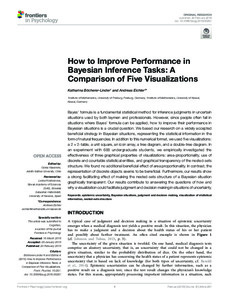| dc.date.accessioned | 2019-05-21T12:18:35Z | |
| dc.date.available | 2019-05-21T12:18:35Z | |
| dc.date.issued | 2019-02-20 | |
| dc.identifier | doi:10.17170/kobra-20190521501 | |
| dc.identifier.uri | http://hdl.handle.net/123456789/11238 | |
| dc.description.sponsorship | Gefördert durch den Publikationsfonds der Universität Kassel | |
| dc.language.iso | eng | |
| dc.rights | Urheberrechtlich geschützt | |
| dc.rights.uri | https://rightsstatements.org/page/InC/1.0/ | |
| dc.subject | epistemic uncertainty | eng |
| dc.subject | Bayesian situations | eng |
| dc.subject | judgment and decision making | eng |
| dc.subject | visualization of statistical information | eng |
| dc.subject | nested-sets structure | eng |
| dc.subject.ddc | 510 | |
| dc.title | How to Improve Performance in Bayesian Inference Tasks: A Comparison of Five Visualizations | eng |
| dc.type | Aufsatz | |
| dcterms.abstract | Bayes’ formula is a fundamental statistical method for inference judgments in uncertain situations used by both laymen and professionals. However, since people often fail in situations where Bayes’ formula can be applied, how to improve their performance in Bayesian situations is a crucial question. We based our research on a widely accepted beneficial strategy in Bayesian situations, representing the statistical information in the form of natural frequencies. In addition to this numerical format, we used five visualizations: a 2 × 2-table, a unit square, an icon array, a tree diagram, and a double-tree diagram. In an experiment with 688 undergraduate students, we empirically investigated the effectiveness of three graphical properties of visualizations: area-proportionality, use of discrete and countable statistical entities, and graphical transparency of the nested-sets structure. We found no additional beneficial effect of area proportionality. In contrast, the representation of discrete objects seems to be beneficial. Furthermore, our results show a strong facilitating effect of making the nested-sets structure of a Bayesian situation graphically transparent. Our results contribute to answering the questions of how and why a visualization could facilitate judgment and decision making in situations of uncertainty. | eng |
| dcterms.accessRights | open access | |
| dcterms.creator | Böcherer-Linder, Katharina | |
| dcterms.creator | Eichler, Andreas | |
| dc.relation.doi | doi:10.3389/fpsyg.2019.00267 | |
| dc.type.version | publishedVersion | |
| dcterms.source.identifier | ISSN: 1664-1078 | |
| dcterms.source.journal | Frontiers in psychology | |
| dcterms.source.pageinfo | 267 | |
| dcterms.source.volume | 10 | |

